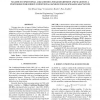Free Online Productivity Tools
i2Speak
i2Symbol
i2OCR
iTex2Img
iWeb2Print
iWeb2Shot
i2Type
iPdf2Split
iPdf2Merge
i2Bopomofo
i2Arabic
i2Style
i2Image
i2PDF
iLatex2Rtf
Sci2ools
ICASSP
2008
IEEE
2008
IEEE
Maximum conditional likelihood linear regression and maximum a posteriori for hidden conditional random fields speaker adaptatio
This paper shows how to improve Hidden Conditional Random Fields (HCRFs) for phone classification by applying various speaker adaptation techniques. These include Maximum A Posteriori (MAP) adaptation as well as a new technique we introduce called Maximum Conditional Likelihood Linear Regression (MCLLR), a discriminative variant of the widely used MLLR algorithm. In previous work, we and others have shown that HCRFs outperform even discriminatively trained HMMs. In this paper we show that HCRFs adapted via MCLLR or via MAP adaptation also work better than similarly adapted HMMs. We also compare MCLLR and MAP adaptation performance with different amounts of adaptation data. MCLLR adaptation performs better when the amount of adaptation data is relatively small, while MAP adaptation outperforms MCLLR with larger amounts of adaptation.
Adaptation Data | ICASSP 2008 | MAP Adaptation | Signal Processing | Speaker Adaptation Techniques |
| Added | 30 May 2010 |
| Updated | 30 May 2010 |
| Type | Conference |
| Year | 2008 |
| Where | ICASSP |
| Authors | Yun-Hsuan Sung, Constantinos Boulis, Daniel Jurafsky |
Comments (0)

